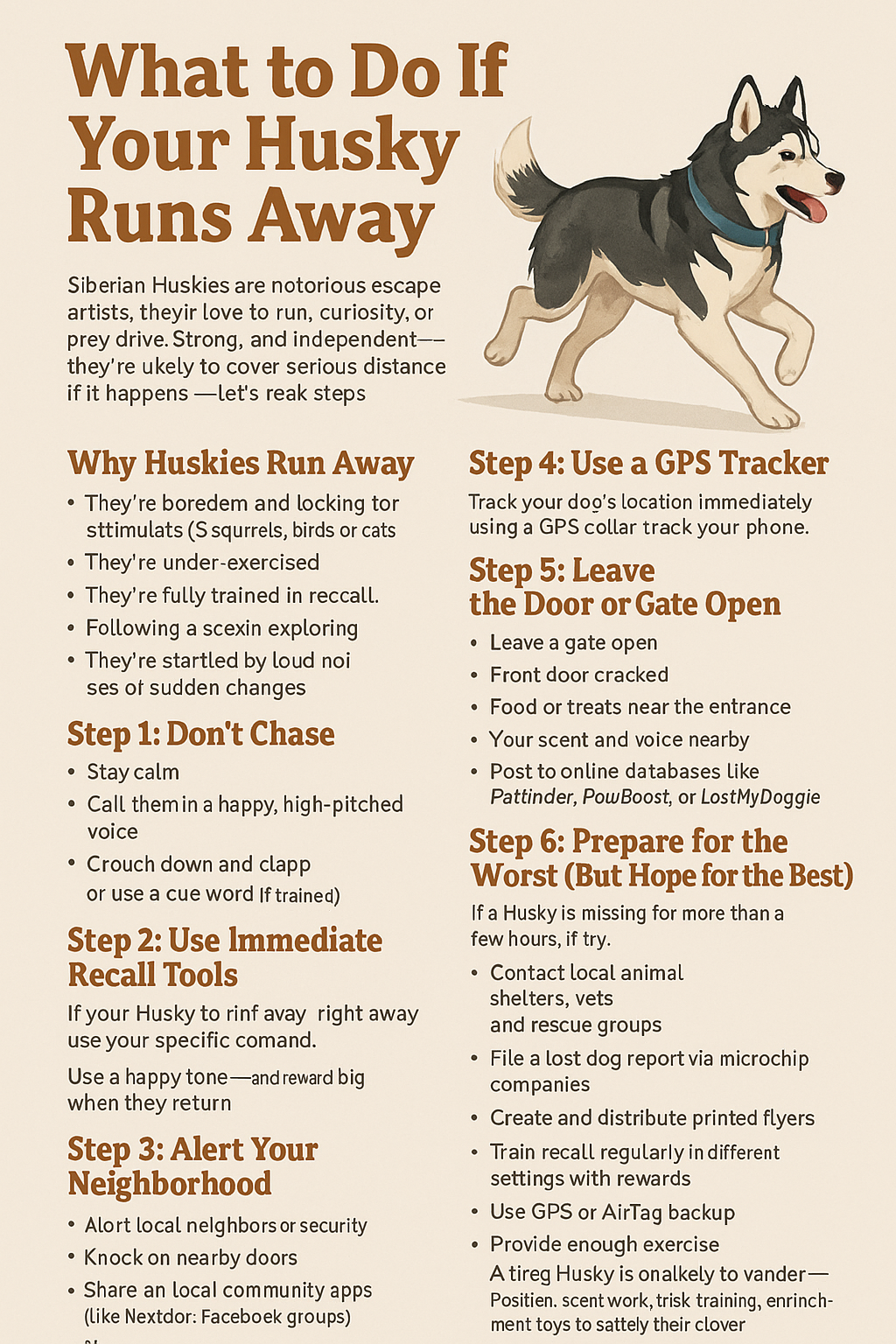If you’ve ever watched your Husky bolt out the door or slip a leash and disappear into the distance, your heart probably dropped. It’s one of the most stressful moments for any dog owner—and with Huskies, it’s unfortunately not that rare.
Siberian Huskies are notorious escape artists. They love to run, they’re curious, and their prey drive is strong. They’re also fast, independent, and can cover serious distance in a short amount of time. But if your Husky runs away—or you’re worried they might—there are steps you can take both to prevent it and to react swiftly and safely if it happens.
Let’s explore why Huskies run, how to prevent it, and what to do if your dog escapes.
Why Huskies Run Away
Understanding the “why” helps you prevent the “how.”
Huskies run away because:
- They’re bored and looking for stimulation
- They see prey like squirrels, birds, or cats
- They’re under-exercised and want to stretch their legs
- They aren’t fully trained in recall
- They’re following a scent or exploring
- They get startled by loud noises or sudden changes
Some Huskies will run even when they seem happy and bonded—this isn’t about love or loyalty, it’s about instinct.
Step 1: Don’t Chase
If your Husky takes off, your first instinct might be to run after them. But this often makes things worse.
Huskies love to run. If you chase them, they may see it as a game—or a threat. Either way, they’ll go faster and farther.
Instead:
- Stay calm
- Call them in a happy, high-pitched voice
- Run in the opposite direction to trigger their chase drive toward you
- Crouch down and clap or use a cue word if trained
Sometimes lying down or acting silly can catch their attention and bring them back. They’re curious—use that to your advantage.
Step 2: Use Immediate Recall Tools
If your Husky is trained in recall, use your specific command right away. Use a happy tone, and be prepared to reward them big when they return—no matter how long they took.
Avoid yelling, scolding, or punishing them when they come back. That just teaches them not to return next time.
Step 3: Alert Your Neighborhood
If they don’t come back quickly, start acting fast:
- Alert local neighbors or security
- Knock on nearby doors
- Share on local community apps (like Nextdoor, Facebook groups)
- Notify animal control or shelters
- Leave an item with your scent (shirt or blanket) outside your home
- Post signs with a photo and contact info
The sooner you get people watching for your dog, the better your chances of a safe return.
Step 4: Use a GPS Tracker
If your Husky wears a GPS collar, track their location immediately via your phone. GPS trackers like Fi or Tractive can save lives in runaway situations.
If your Husky doesn’t have one yet, consider investing—especially if you know they’re prone to escaping.
Step 5: Leave the Door or Gate Open
Dogs often return to the point of escape once they calm down or get tired. Leave:
- A gate open
- The front door cracked
- Food or treats near the entrance
- Your scent and voice nearby
Stay within sight but don’t crowd the area—they may return when they feel it’s safe and quiet.
Step 6: Prepare for the Worst (But Hope for the Best)
If your Husky is missing for more than a few hours:
- Contact local animal shelters, vets, and rescue groups
- File a lost dog report with microchip companies
- Create and distribute printed flyers
- Post to online databases like Petfinder, PawBoost, or LostMyDoggie
- Search on foot regularly—early morning and dusk are best times
Many dogs are found within 24–48 hours, especially if chipped, tagged, and reported quickly.
Prevention Tips: Keep It From Happening Again
Huskies will always have the instinct to run—but you can reduce the risk.
1. Use Secure Fencing
- At least 6 feet high
- Bury wire or concrete to prevent digging
- Double gates or enclosed entry zones
- Lock latches (some Huskies open them!)
2. Never Trust Off-Leash in Open Areas
Even with good recall, Huskies aren’t safe off-leash unless in a fenced environment.
3. Microchip and ID Tag
Make sure your dog’s chip is registered and info is up to date. Use a durable tag with your number on their collar.
4. Train Recall Regularly
Don’t just teach it once—practice daily in different settings and with rewards that matter.
5. Use GPS or AirTag Backup
Trackers aren’t perfect, but they give you an edge. Clip one to the collar for peace of mind.
6. Provide Enough Exercise
A tired Husky is far less likely to wander. Give them outlets for energy every single day.
7. Mental Stimulation
Boredom leads to escape. Use puzzles, scent work, trick training, and enrichment toys to satisfy their clever minds.
Final Thoughts: Plan Ahead, Act Fast
When a Husky runs away, time matters—but so does calm thinking. Don’t panic, don’t chase, and don’t give up. Most runaways are found—but prevention is always the better path.
Secure your home, keep their brain and body engaged, and always train with trust and rewards.
Because a Husky with adventure in their heart will always run—unless you give them enough reasons to stay.
